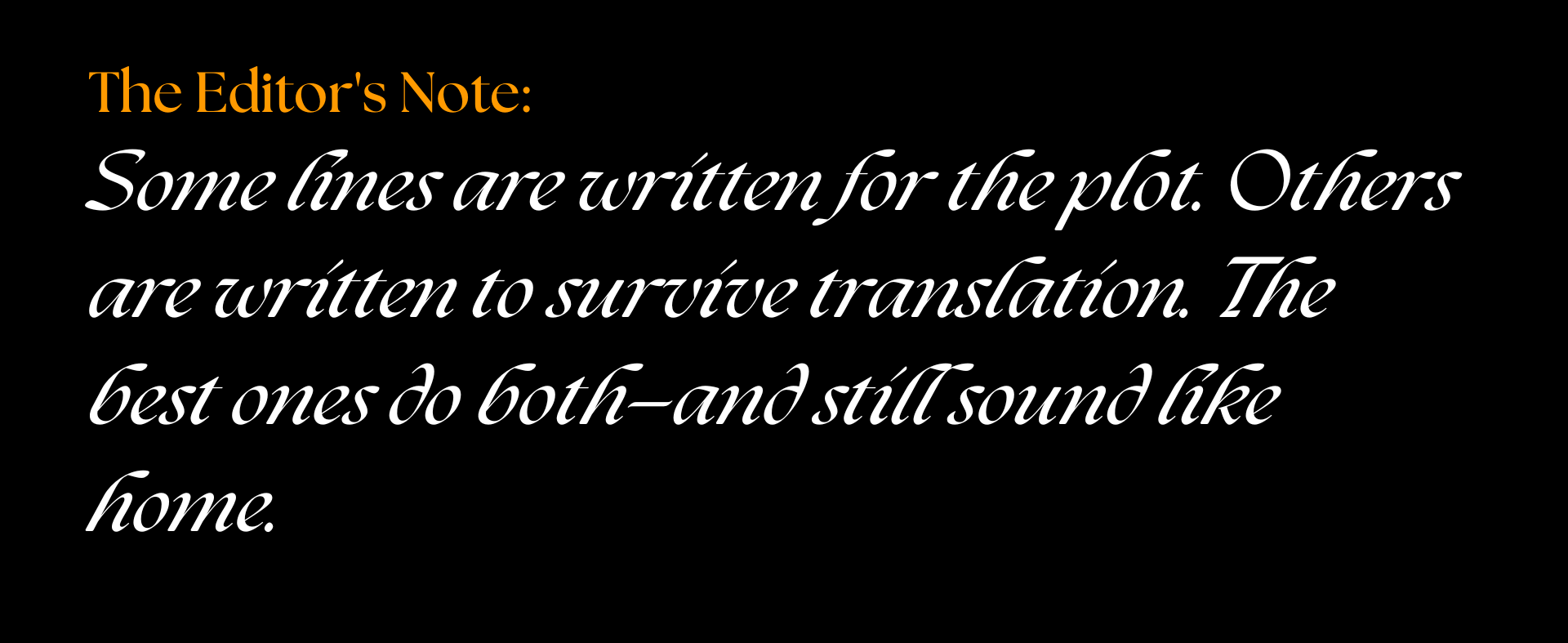Writing Across Worlds: Hyperlocal and Hyperglobal Storytelling

Why Dialogue Is the First Place Global Meets Local and Often, the First Place It Breaks
The Indian screenwriter in 2025 is writing into a complex equation. It’s no longer about one audience or one platform. Every script is now a multi-stakeholder document. A producer in Mumbai. A streamer’s exec in Singapore. A subtitler in LA. A marketing team in Noida. A viewer in Kochi. Another in New Jersey. Same scene, different frequencies.
And yet, amidst all this complexity, one constant has emerged: dialogue reveals everything. Not just character or intent, but also whether your story is truly calibrated for today’s layered audience.
From Multiplex to Multiverse: Who Are We Really Writing For?
Let’s look at what the numbers tell us:
- In 2024, 17 Indian films crossed the ₹100 crore mark at the domestic box office. That included local-language hits like HanuMan (Telugu) and Premalu (Malayalam) both of which retained heavy cultural signatures.
- Global streaming audiences grew by 18% year-on-year across Indian originals, with dubbed and subtitled content outperforming platform expectations in regions like Germany, UAE, and the UK.
- According to a Netflix report, viewers are 3x more likely to complete a non-Hindi Indian film if the subtitles feel “true to tone and emotion,” not just translated word-for-word.
These numbers underline a simple truth: the Indian cinematic voice is no longer local or global it must be both. And your dialogue is the front line of that balancing act.
Common Missteps: Why Dialogue Fails to Land
In our work with writers’ rooms, screenplay consultancies, and subtitling teams, we find four consistent problems:
- Over-sanitisation: Replacing regionally rooted language with vanilla Hindi or Hinglish in fear of alienating audiences.
- Over-explanation: Using expositional dialogue to spoon-feed cultural context, killing rhythm in the process.
- Platform overreach: Changes suggested to "smooth tone" often strip character voices, resulting in monolithic emotion.
- Subtitles as afterthought: Many writers don’t factor subtitle viability during writing. Yet, subtitlers often face unclear metaphors or wordplay that don’t travel.
Example:
A raw line like "tu maar khayega, par chhodega nahi” from Darlings landed because it wasn’t “polished.” It was emotionally legible even for audiences unfamiliar with the language. That emotional specificity traveled further than any generic English equivalent.
Case Studies: Dialogue That Balanced Precision and Reach
- Kantara (2022): Kept rituals intact and didn’t simplify the dialect. The soundscape became part of the experience and audiences leaned in, not out.
- Jubilee (2023): Balanced the feel of 1940s speech with natural emotional pacing. No heavy exposition, but the period tone was never compromised.
- Delhi Crime (2019–2022): Used silence and body language as dialogue in itself. Class differences were encoded in tone, not just lines.
- Class (2023): Though adapted from Elite, its local dialogues were rewritten to reflect caste, class, and Delhi elite linguistics without genericising the emotional beats.
Tips for Writers, Showrunners, and Directors
1. Identify Your Primary Cultural Code:
Are your characters from East UP? Are they Catholic Goans? From Banjara Hill wealth or Juhu middle-class apartments? Write from within that register. Global appeal doesn’t mean flattening that core.
2. Map Dialogue to Power, Not Just Plot:
Who interrupts whom? Who never says “thank you”? Who switches languages mid-sentence, and why? That’s cultural layering. Respect it.
3. Think Subtitles Early:
If a joke, emotion, or power play depends on a language-specific phrase, work with your subtitler early on. Good subtitles aren't literal — they’re contextual.
4. Avoid “Pan-India” Homogenisation:
Writing neutral Hindi or English to serve the “whole country” usually serves no one. Instead, embed character-specific speech and let the surrounding tools (direction, acting, camera) carry the cultural nuance.

What Platforms Are Actually Looking For
It’s a myth that platforms want neutral content. What they want is legible conviction.
- Amazon's 2023 India Originals report showed that character-driven, culturally steeped shows had higher completion rates, even outside their primary markets.
- Netflix’s subtitling teams now push for “emotional intent translation” instead of direct translation especially for Indian originals.
- Disney+ Hotstar’s regional programming saw more repeat watches for series that embedded regional idioms and rituals, like November Story (Tamil) and Grahan (Hindi).
What does that mean for your script? Clarity and context beat simplification.

Conclusion: Dialogue Is Not Decoration. It’s Structure.
For Indian screenwriters, 2025 is not just about learning to write better. It’s about learning to write across class divides, platform expectations, subtitle limitations, and cultural complexity without losing voice.
If you’re a showrunner: ensure your writers’ room has at least one person from the character’s background.
If you’re a director: preserve linguistic authenticity in rehearsal, even if it means tweaking the script.
If you’re a writer: trust that specificity is your superpower not a hurdle.
Because your line won’t reach Berlin or Bangalore if it doesn’t land first with the character who says it.

